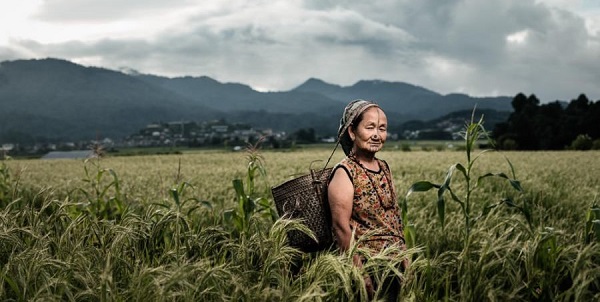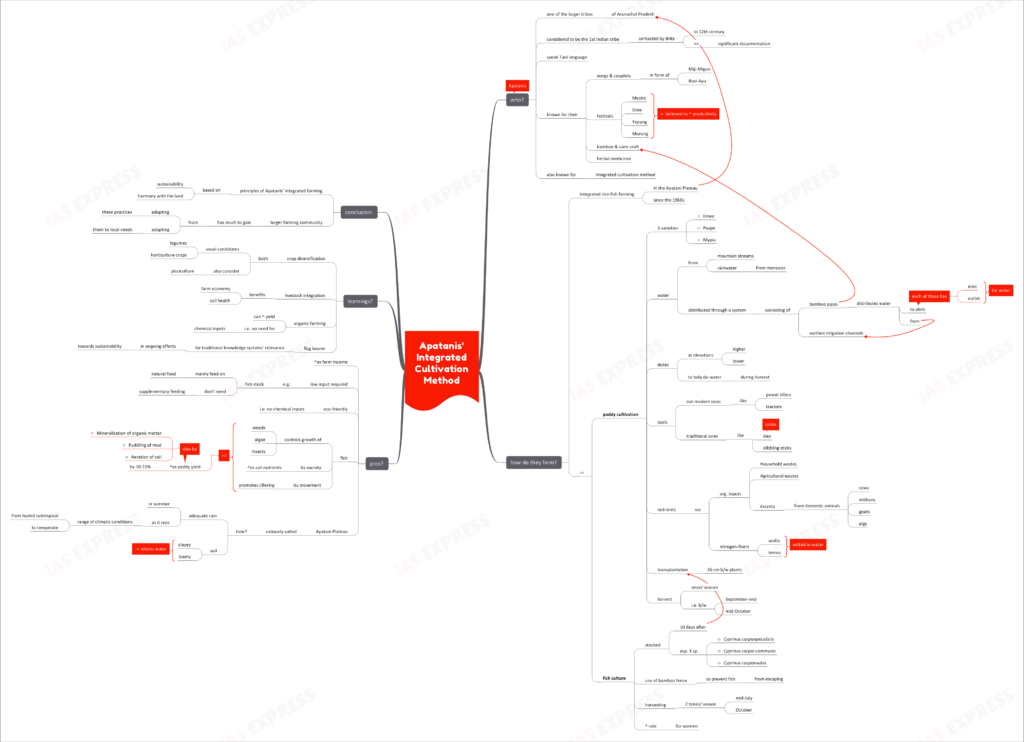Apatanis’ Integrated Cultivation Method- Lessons in Sustainability

From Current Affairs Notes for UPSC » Editorials & In-depths » This topic
IAS EXPRESS Vs UPSC Prelims 2024: 85+ questions reflected
The Apatanis are one of the major ethnic groups in the eastern Himalayan region. Their culture and traditions have been much documented since the 12th century. Going forward, the larger agricultural sector has much to learn from their farming methods.

Who are the Apatanis?
- The Apatanis are one of the larger tribes of Arunachal Pradesh.
- The Apatanis are considered to be the 1st Indian tribe to have come in contact with the British, in the 12th century. As a result, there is significant documentation of their traditions over the years.
- They speak the Tani language and are known for their songs and couplets in the form of Miji-Migun and Busi-Ayu. Their festivals include Myoko, Dree, Yapung and Murung- which are considered to ensure productivity.
- Apart from their cane and bamboo crafts and herbal remedies, the Apatanis are known for their method of paddy and fish culture.
How do they farm?
- The Apatanis have been undertaking integrated rice-fish farming in the Apatani Plateau of Arunachal Pradesh, since the 1960s.
Paddy cultivation:
- The tribal farmers primarily cultivate 3 paddy varieties in this method:
- Emeo
- Pyape
- Mypia
- Water is sourced from mountain streams and rainwater during the monsoon. For water distribution, a system of earthen irrigation channels and bamboo pipes are used.
- Bamboo pipes distribute water from the channels to the plots.
- Each plot has different pipes for inlet and outlet of water.
- Dykes, constructed at higher and lower elevations, help de-water the fields during harvest.
- Instead of modern agricultural tools like power tillers and tractors, the farmers use old-fashioned tools like sickle (called ‘dao’) and dibbling sticks.
- To improve the nutritive quality of the soil, the farmers sometime use organic inputs like:
- Household wastes
- Agricultural wastes
- Excreta from domestic animals like cows, mithuns (a cattle), goat and pigs
- Nitrogen-fixing azolla and lemna are grown in the water. This further improves soil nutrients.
- After the plots are prepared, the farmers transplant the healthy plants with an average distance of 26 cm between each other.
- The paddy harvest takes place once a season i.e. September-end to mid-October.
Fish Culture:
- In addition to paddy cultivation, pisci-culture is undertaken in the same field.
- The fishes are stocked 10 days after the paddy is transplanted. 3 common carp species are the most stocked:
- Cyprinus carpiospecularis
- Cyprinus carpio communis
- Cyprinus carpionudus
- To prevent the fish from escaping, bamboo fencing is used.
- Fish harvesting takes place twice a season. The first harvest is done in the middle of July and the second harvest is in October.
- There is division of labour between the men and the women. For instance, women are more involved in the fish culture part.
What are the pros?
- This side-by-side practice of agriculture and pisciculture improves the farmers’ income.
- The method requires low input and is eco-friendly. For instance, the fish stock mostly depends on the natural food provided by the paddy fields and don’t require supplementary feeding.
- The fish control the growth of weeds, algae and insects. Its excreta enhances soil nutrients and its movement promotes tillering, helping improve paddy productivity by 10-15%.
- The paddy yield is also increased by:
- Mineralization of organic matter
- Puddling of mud
- Aeration of soil
- The Apatani Plateau is uniquely suited to this method of cultivation.
- The plateau receives adequate rain in the summer time, as the plateau represents a range of climatic conditions- from humid subtropical to temperate.
- The plateau has a clayey loamy texture which ensures water retention.
What can be learnt from this method?
- The importance of crop diversification is one of the key takeaways of Apatani way of farming. Apart from the usual candidates like legumes and horticulture crops, farmers could also consider pisciculture.
- Integration of livestock rearing into farming can prove beneficial not only for the farm economy but also for the soil health.
- The system shows how farms can improve yield without resorting to chemical inputs.
- The Apatani way of farming is also a flag-bearer for traditional knowledge systems’ relevance for the ongoing efforts towards sustainability.
Conclusion:
The principles of Apatanis’ integrated farming are based on sustainability and harmony with the land. The larger farming community has much to gain from adopting these principles and adapting them to suit local needs.
Practice Question for Mains:
How do the Apatanis cultivate their land? What lessons can be learnt from their traditional integrated farming system? (250 words)
If you like this post, please share your feedback in the comments section below so that we will upload more posts like this.

